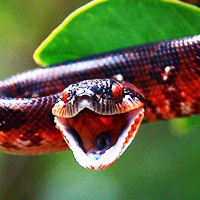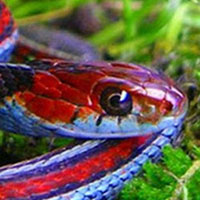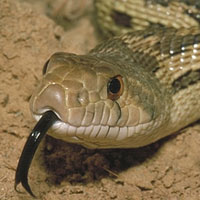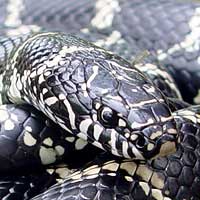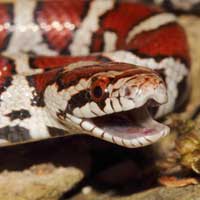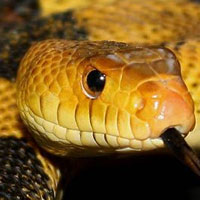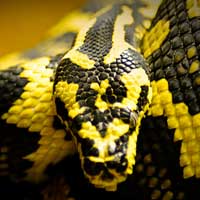Everything You Need to Know About the Green Rat Snake
The Green Rat Snake, scientifically known as Senticolis triaspis, belongs to the Colubridae family, which is the largest family of snakes, encompassing a wide variety of non-venomous and mildly venomous species recognized for their adaptability and extensive geographic distribution.
Scientific Name: Senticolis triaspis
Snake Family: Colubridae
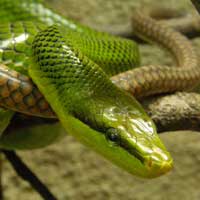
Introduction to the Green Rat Snake
The Green Rat Snake (*Senticolis triaspis*), also known as the Mexican Green Rat Snake, is a striking non-venomous species native to Central America and parts of the southwestern United States. Known for its vibrant green scales and calm temperament, this snake is a favorite among reptile enthusiasts. With proper care, the Green Rat Snake can thrive in captivity, making it an excellent choice for both novice and experienced snake keepers.
Creating the Perfect Habitat for the Green Rat Snake
To ensure your Green Rat Snake thrives, it’s essential to replicate its natural environment. These snakes are commonly found in forests, grasslands, and rocky terrains. Key habitat elements include:
- Enclosure Size: A 40-gallon tank is ideal for adults, offering ample space for movement and climbing.
- Temperature Gradient: Maintain daytime temperatures of 75-85°F with a basking spot at 90°F, and nighttime temperatures around 65-75°F.
- Humidity: Keep humidity levels between 50-70%, achieved with regular misting and a water dish.
- Substrate: Use coconut fiber, aspen shavings, or a soil-sand mix to mimic their natural ground cover.
- Enrichment: Provide climbing branches, hides, and rocks to encourage natural behaviors like climbing and exploration.
Refer to the table below for habitat setup guidelines:
| Habitat Element | Specifications |
|---|---|
| Enclosure Size | 40+ gallons |
| Temperature | 75-85°F (day), 65-75°F (night) |
| Humidity | 50-70% |
| Substrate | Coconut fiber, aspen shavings, soil-sand mix |
Feeding the Green Rat Snake: Diet and Tips
The Green Rat Snake is a carnivorous species with straightforward dietary needs. Here are feeding recommendations:
- Juveniles: Feed pinky mice every 5-7 days.
- Subadults: Offer small to medium-sized mice every 7-10 days.
- Adults: Provide adult mice or small rats every 10-14 days.
- Prey Type: Always use pre-killed prey to prevent injuries during feeding.
- Hydration: Ensure a fresh supply of water in a shallow dish for drinking and soaking.
Consistency in feeding supports the snake’s growth and health.
Behavior and Temperament of the Green Rat Snake
The Green Rat Snake is known for its active and curious nature, making it an engaging pet. Key behavioral traits include:
- Diurnal Activity: These snakes are primarily active during the day, allowing for plenty of observation opportunities.
- Climbing Enthusiasts: They love climbing, so providing vertical space and sturdy branches is essential.
- Docile Temperament: They are generally calm and easy to handle with regular interaction.
- Defensive Behavior: When threatened, they may hiss or vibrate their tail, but they rarely bite.
Understanding their behavior ensures a stress-free and enriching environment.
Health and Lifespan of the Green Rat Snake
The Green Rat Snake has a lifespan of 15-20 years in captivity with proper care. Key aspects of maintaining their health include:
- Common Health Issues: Look out for respiratory infections, mite infestations, and improper shedding.
- Preventative Measures: Maintain consistent temperature, humidity, and cleanliness in their enclosure.
- Veterinary Care: Regular check-ups with an exotic animal vet are essential to monitor their health.
- Observation: Watch for signs of stress or illness, such as lethargy, loss of appetite, or unusual behavior.
Proper husbandry practices ensure a long and healthy life for your snake.
Reproduction and Breeding of the Green Rat Snake
Breeding the Green Rat Snake in captivity can be a rewarding experience. Key factors to consider include:
- Breeding Season: Typically occurs in spring after a winter brumation period.
- Clutch Size: Females lay 6-12 eggs per clutch.
- Incubation: Eggs should be incubated at 80-85°F for 50-60 days.
- Hatchling Care: Provide small enclosures and appropriately sized prey for hatchlings.
Successful breeding requires careful preparation and monitoring of both the male and female snakes.
Tips for Handling and Caring for the Green Rat Snake
Handling and caring for the Green Rat Snake is straightforward with proper knowledge. Here are some tips:
- Handle the snake gently, supporting its entire body to minimize stress.
- Avoid handling immediately after feeding to prevent regurgitation.
- Keep the enclosure clean and enriched with climbing structures and hiding spots.
- Monitor their health and behavior regularly to identify signs of stress or illness early.
- Provide consistent interaction to build trust and ensure a well-adjusted pet.
Proper handling and care help establish a strong bond with your Green Rat Snake and ensure its long-term well-being.
Other Snakes In This Species
 Aesculapian Rat Snake
Aesculapian Rat Snake Amur Russian Rat Snake
Amur Russian Rat Snake Bairds Rat Snake
Bairds Rat Snake Black Rat Snake
Black Rat Snake Chinese Twin-spotted Rat Snake
Chinese Twin-spotted Rat Snake Diadem Rat Snake
Diadem Rat Snake Diones Rat Snake
Diones Rat Snake Eastern Fox Snake
Eastern Fox Snake Everglades Rat Snake
Everglades Rat Snake Four-lined Rat Snake
Four-lined Rat Snake Gray Rat Snake
Gray Rat Snake Great Plains Rat Snake
Great Plains Rat Snake Green Rat Snake
Green Rat Snake Ladder Rat Snake
Ladder Rat Snake Leopard Rat Snake
Leopard Rat Snake Mandarin Rat Snake
Mandarin Rat Snake Radiated Rat Snake
Radiated Rat Snake Steppes Rat Snake
Steppes Rat Snake Texas Rat Snake
Texas Rat Snake Trans-Pecos Rat Snake
Trans-Pecos Rat Snake Trinket Rat Snake
Trinket Rat Snake Yellow Rat Snake
Yellow Rat Snake
